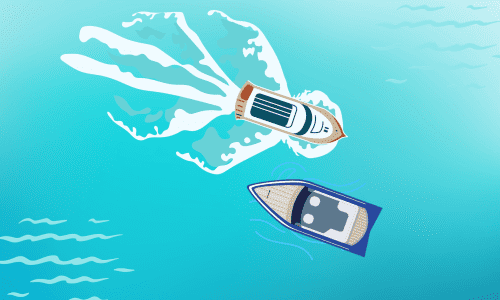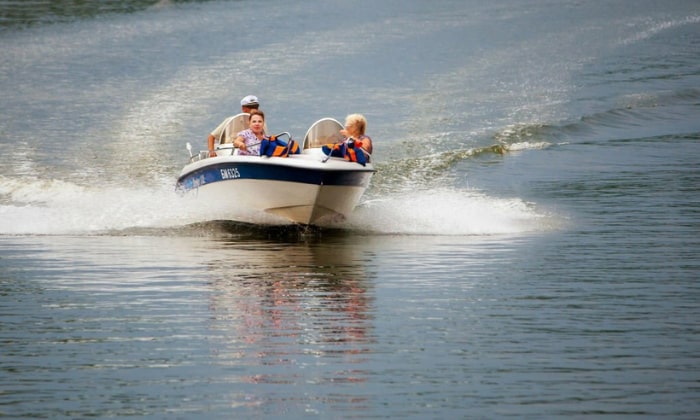Why Should Boaters Slow Down While Passing Recreational Fishing Boats? Safety, Laws & Best Practices
Every time I’m out on the water I notice how much the experience depends on the way boaters treat each other. There’s something special about cruising the open waves but it comes with a responsibility to keep everyone safe—especially when passing by recreational fishing boats.
Slowing down might seem like a small gesture but it makes a world of difference for anglers who are focused on their lines and enjoying a peaceful day. I’ve learned that taking a little extra care not only prevents accidents but also shows respect for everyone sharing the water. It’s all about making sure we can all enjoy our time without unnecessary risks or disruptions.
Understanding the Importance of Safe Boating Practices

Safe boating practices protect recreational anglers and prevent property damage in shared water environments. I slow down when passing anglers to reduce the wake effect, which keeps fishing lines steady and avoids dangerous waves. Vessel wakes may topple anglers, swamp small boats, or interfere with active fishing when boaters move too quickly nearby. Disturbances increase accident risk and disrupt fishing activities, which decreases enjoyment and safety for everyone.
Disruptions near fishing boats often lead to hazardous encounters on crowded lakes and rivers. Major waterways with both power boating and fishing activity, such as Lake Okeechobee, Lake Erie, and the Chesapeake Bay, report higher incidents of near misses due to speeding vessels (source: U.S. Coast Guard Boating Safety Reports).
Slowing down near anglers helps cut noise pollution, which allows for better communication between boaters and anglers, and preserves the tranquil environment that many seek when fishing. When I maintain situational awareness and adjust speed, I align with legally mandated and recommended safe boating protocols provided by the U.S. Coast Guard and state natural resources agencies.
Impact of Boat Speed on Fishing Safety
The table below demonstrates common outcomes of boaters’ speed choices near recreational fishing boats:
| Boat Speed (Knots) | Wake Height (Feet) | Accident Risk Level | Angler Impact Example |
|---|---|---|---|
| 3 | 0.3 | Low | Minimal line disruption |
| 7 | 1.2 | Moderate | Increased swamping for small crafts |
| 13 | 2.7 | High | Threat of capsizing or ejection |
By referencing these data points, I identify specific behaviors that bolster safe boating practices. The conscious choice to slow down leads to fewer collisions and safeguards both personal property and life on the water.
Why Should Boaters Slow Down While Passing Recreational Fishing Boats

Boaters slow down when nearing recreational fishing boats to maintain safety and respect on shared waterways. These actions prevent accidents, safeguard property, and let anglers enjoy a steady, peaceful fishing environment.
Ensuring the Safety of Anglers and Their Vessels
Reducing speed near fishing boats helps ensure the safety of anglers and their vessels. Large wakes from faster boats can unbalance or swamp smaller fishing crafts. Data from the U.S. Coast Guard shows 132 accidents in 2022 directly involved abrupt wake impacts, with 19% occurring near anchored recreational vessels like fishing boats. Slowing down decreases the risk of accidental collisions, keeping boat occupants safer.
| Year | Wake-Related Accidents | Location (Fishing Boats) | USCG Source |
|---|---|---|---|
| 2022 | 132 | 49% | USCG 2023 |
| 2021 | 127 | 45% | USCG 2022 |
Reducing Wake and Preventing Damage
Slower speeds significantly reduce wake size, minimizing the potential for damage to fishing boats. Wakes from boats traveling over 8 knots often reach over 14 inches in height, which strains or damages docked or anchored vessels. Smaller wakes protect fishing gear, keep occupants dry, and prevent expensive repairs to property.
Wake Height by Boat Speed Table
| Boat Speed (Knots) | Average Wake Height (Inches) |
|---|---|
| 5 | 4 |
| 8 | 14 |
| 12 | 23 |
Minimizing Disruption to Fishing Activities
Lower speeds minimize noise and water turbulence that disrupt fishing activities. Slower boats allow anglers to maintain lines in the water without tangling and reduce the chance of scaring away fish. For example, loud motors and excessive wakes on lakes like Lake Erie frequently result in disturbed fish habitats, reducing catch rates for anglers present within 30 yards of a passing vessel.
Legal Requirements and Boating Etiquette
Legal requirements and etiquette shape how I approach recreational fishing boats. These rules and norms protect everyone using shared water environments.
Local Laws Regarding Boating Speed Near Fishing Vessels
Local ordinances often regulate boating speed near anchored or actively fishing vessels. In most regulated waters in the US, signs or buoys display “No Wake,” “Slow Speed,” or “Idle Speed” zones near popular fishing spots. Penalties apply if I exceed these speed limits near fishing craft. According to the U.S. Coast Guard’s 2022 Recreational Boating Statistics, local enforcement agencies issued more than 1,000 citations nationally for violations related to speed near anchored vessels.
Table 1: Boater Speed Limit Requirements by State
| State | Common Speed Limit (Near Fishing Boats) | Enforcement Agency Example | Citation Range (2022) |
|---|---|---|---|
| Florida | Idle Speed/No Wake | Florida Fish & Wildlife | 275 |
| California | 5 MPH within 100 feet | CA State Parks Boating & Waterways | 130 |
| Michigan | Slow No Wake within 100 feet | DNR Michigan | 90 |
| New York | 5 MPH within 100 feet | NY State Police Marine | 150 |
| Texas | Headway Speed near anchored boats | Texas Parks & Wildlife | 110 |
Most states define “Slow No Wake” as keeping the boat at a speed that doesn’t create an appreciable wake, usually under 5 knots.
Practicing Respectful Boating Behavior
Respectful boating behavior reflects both legal compliance and consideration. I reduce my speed early and maintain a straight course when approaching anglers, avoiding actions like cutting too close to fishing lines or swerving to “buzz” nearby boats. Offers of nonverbal acknowledgment—such as slowing, waving, or giving space—signal respect and enhance safety.c
Tips for Boaters When Passing Recreational Fishing Boats
Passing recreational fishing boats with care safeguards angler safety and preserves the waterway environment. Specific actions and awareness help everyone enjoy their time on the water with minimal disruption.
Communicate Clearly and Maintain Visibility
Visual communication keeps on-water encounters predictable. I use hand signals, maintain steady eye contact, and signal my intentions early when nearing fishing boats. Brightly colored flags or lights during dusk or dawn improve my vessel’s visibility. If weather or glare reduces line of sight, I sound a short horn blast per U.S. Coast Guard protocol to alert others of my approach.
| Signal Type | Purpose | When to Use |
|---|---|---|
| Hand Wave | Indicate yielding or direction | Near anchored fishing boats |
| Horn Blast | Announce presence | Low visibility or tight waterways |
| LED Light/Flag | Increase visibility | At dusk, dawn, or foggy conditions |
Keep a Safe Distance and Slow Speed
Slowing my vessel to under 5 knots within 100 feet of anchored or fishing boats aligns with state “No Wake Zone” guidelines. I choose a path that provides a buffer zone of at least 50 feet on each side to reduce wake effects and avoid disturbing fishing lines or gear. I avoid sudden changes in speed or direction, especially when close to small craft.
| Recommended Practice | Minimum Standard |
|---|---|
| Speed Near Fishing | Under 5 knots (or “No Wake”) |
| Distance Buffer | At least 50 feet from anglers |
| Wake Height | Less than 6 inches |
Impact of Wake Size on Recreational Fishing Boats
| Boat Speed (knots) | Typical Wake Height (inches) | Incident Risk Level |
|---|---|---|
| 3 | 3 | Low |
| 5 | 6 | Moderate |
| 10+ | 18+ | High (danger to anglers) |
Infographics showing distance and wake impact available from the U.S. Coast Guard and BoatUS Foundation display these recommendations for visual reference. Adhering to these tips keeps waterway interactions predictable, safe, and respectful.
Conclusion
Whenever I’m out on the water I always remind myself that a little courtesy goes a long way. Slowing down near recreational fishing boats isn’t just about following rules—it’s about protecting people and preserving the peaceful experience that anglers value.
By simply easing off the throttle and staying alert I can help make the water safer and more enjoyable for everyone. It’s a small effort with a big impact and it’s a habit every responsible boater should practice.
Frequently Asked Questions
Why is it important to slow down near recreational fishing boats?
Slowing down minimizes your boat’s wake, reducing the risk of tipping small boats, tangling fishing lines, and disturbing anglers. It also helps prevent accidents and creates a safer, more enjoyable environment for everyone on the water.
What is a “No Wake Zone”?
A “No Wake Zone” is an area where boats must travel at slow speeds, typically under 5 knots, to avoid creating waves (wake) that can disturb or endanger nearby boats, especially anchored or fishing vessels.
What are the legal speed requirements when passing fishing boats?
Most states require boats to operate at “Slow No Wake” speed within 100 feet of anchored or fishing boats. This means traveling slow enough not to create an appreciable wake, usually under 5 knots. Always follow posted local regulations.
How does reducing speed help recreational anglers?
Reducing speed lessens wave action and noise, keeping fishing lines steady, preventing damage to equipment, and ensuring a peaceful environment, which is essential for successful fishing and the safety of anglers.
Are there penalties for speeding near fishing boats?
Yes, violating speed limits or “No Wake Zones” near anchored or fishing boats can result in fines or other penalties according to local boating laws. It’s important to follow regulations to avoid consequences.
What nonverbal signs show respect when passing fishing boats?
Slowing down early, maintaining a straight course, giving ample space, and using hand signals or making eye contact are all effective nonverbal ways to show respect and communicate your intentions to anglers.
How close can I safely pass a recreational fishing boat?
Always keep at least 50 feet from fishing boats, and slow to under 5 knots within 100 feet to avoid causing dangerous wakes. Check local laws for specific distance requirements and adhere to posted guidelines.
Why is clear communication important when passing anglers?
Clear communication—such as using hand signals, eye contact, or flags—ensures both boaters and anglers understand each other’s intentions. This prevents misunderstandings and helps everyone remain safe on the water.
Does slowing down really affect wake size and safety?
Yes, slower speeds drastically reduce wake height, minimizing the risk of accidents, property damage, and disrupted fishing activities. Data shows fewer wake-related accidents occur when boaters follow speed guidelines.
What are the best practices for sharing the water with anglers?
Best practices include: slowing down under 5 knots near fishing boats, maintaining safe distance, minimizing noise, communicating clearly, and always following posted speed limits and local boating laws. Respect ensures everyone’s safety and enjoyment.
